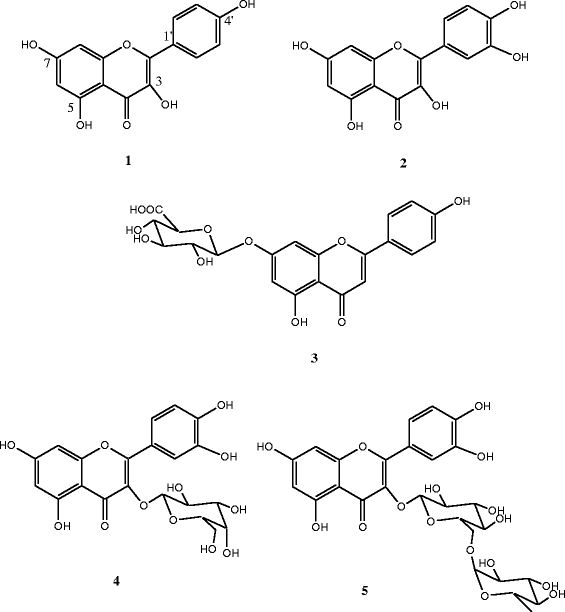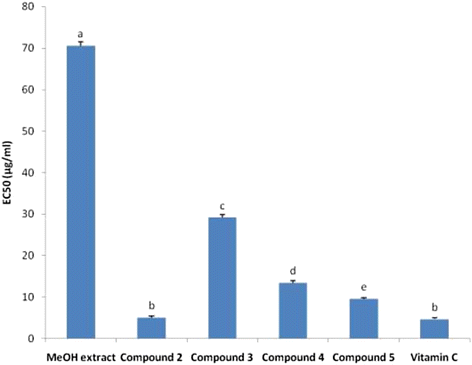Antimicrobial and antioxidant flavonoids from the leaves of Oncoba spinosa Forssk. (Salicaceae)
- PMID: 25928352
- PMCID: PMC4424558
- DOI: 10.1186/s12906-015-0660-1
Antimicrobial and antioxidant flavonoids from the leaves of Oncoba spinosa Forssk. (Salicaceae)
Abstract
Background: Naturally occurring flavonoids have been reported to possess various pharmacological properties. The aim of this study was to evaluate the antimicrobial and antioxidant activities of the MeOH extract and flavonoids from the leaves of Oncoba spinosa, a plant used for the treatment of syphilis, wounds and sexual impotence.
Methods: The plant extract was prepared by maceration in methanol and sequentially fractionated by column chromatography. The structures of isolated compounds were elucidated on the basis of spectral studies and comparison with published data. The MeOH extract and its isolated compounds were evaluated for their antibacterial and antifungal activities by broth microdilution method. The 1,1-diphenyl-2-picrylhydrazyl (DPPH) and trolox equivalent antioxidant capacity (TEAC) assays were used to detect the antioxidant activity. The samples were tested spectrophotometrically for their hemolytic properties against human red blood cells.
Results: The fractionation of the MeOH extract afforded five known flavonoids including kaempferol (1), quercetin (2), apigenin-7-O-β-D-glucuronopyranoside (3), quercetin 3-O-β-D-galactopyranoside (4) and quercetin 3-O-α-L-rhamnopyranosyl (1 → 6) β-D-glucopyranoside (5). The MeOH extract displayed weak to moderate antimicrobial activities (MIC = 256-2048 μg/ml). Quercetin 3-O-α-L-rhamnopyranosyl (1 → 6) β-D-glucopyranoside (5) and quercetin (2) were respectively the most active compounds against bacteria (MIC = 8-64 μg/ml) and fungi (MIC = 64 - 128 μg/ml). These tested samples also showed high radical-scavenging activities (EC50 = 5.08 - 70.56 μg/ml) and gallic acid equivalent antioxidant capacities (TEAC = 53.76 - 89.86 μg/ml) when compared with vitamin C (EC50 = 4.72 μg/ml). The MeOH extract and compounds 2-5 were non-toxic to human red blood cells indicating their high selectivity to be used as antimicrobial and antioxidant drugs.
Conclusion: The MeOH extract of O. spinosa as well as compounds 2 - 5 could be a potential source of natural antimicrobial and antioxidant products.
Figures



Similar articles
-
Antibacterial, antifungal and antioxidant activities of whole plant chemical constituents of Rumex abyssinicus.BMC Complement Med Ther. 2021 Jun 5;21(1):164. doi: 10.1186/s12906-021-03325-y. BMC Complement Med Ther. 2021. PMID: 34090405 Free PMC article.
-
A new flavonol glycoside and biological activities of Adenanthera pavonina L. leaves.Nat Prod Res. 2014;28(5):282-9. doi: 10.1080/14786419.2013.856903. Epub 2013 Nov 29. Nat Prod Res. 2014. PMID: 24289202
-
Antimicrobial and antioxidant activity of kaempferol rhamnoside derivatives from Bryophyllum pinnatum.BMC Res Notes. 2012 Mar 20;5:158. doi: 10.1186/1756-0500-5-158. BMC Res Notes. 2012. PMID: 22433844 Free PMC article.
-
A Systematic Review on Phytochemistry, Ethnobotany and Biological Activities of the Genus Bunium L.Chem Biodivers. 2021 Nov;18(11):e2100317. doi: 10.1002/cbdv.202100317. Epub 2021 Oct 20. Chem Biodivers. 2021. PMID: 34554642
-
Quercetin, the Potential Powerful Flavonoid for Human and Food: A Review.Front Biosci (Elite Ed). 2024 Sep 24;16(3):30. doi: 10.31083/j.fbe1603030. Front Biosci (Elite Ed). 2024. PMID: 39344383 Review.
Cited by
-
Sex-Dependent Effects of PM2.5 Maternal Exposure and Quercetin Intervention on Offspring's Short Chain Fatty Acids.Int J Environ Res Public Health. 2019 Nov 8;16(22):4371. doi: 10.3390/ijerph16224371. Int J Environ Res Public Health. 2019. PMID: 31717430 Free PMC article.
-
Aronia melanocarpa Extract Fermented by Lactobacillus plantarum EJ2014 Modulates Immune Response in Mice.Antioxidants (Basel). 2021 Aug 11;10(8):1276. doi: 10.3390/antiox10081276. Antioxidants (Basel). 2021. PMID: 34439524 Free PMC article.
-
Antibacterial and Antioxidant Activities of Isolated Compounds from Prosopis africana Leaves.Int J Anal Chem. 2022 Feb 17;2022:4205823. doi: 10.1155/2022/4205823. eCollection 2022. Int J Anal Chem. 2022. PMID: 35222646 Free PMC article.
-
Antimicrobial and Antioxidant Secondary Metabolites from Trifolium baccarinii Chiov. (Fabaceae) and Their Mechanisms of Antibacterial Action.Biomed Res Int. 2021 Oct 22;2021:3099428. doi: 10.1155/2021/3099428. eCollection 2021. Biomed Res Int. 2021. PMID: 34722760 Free PMC article.
-
Anti-Fungal Efficacy and Mechanisms of Flavonoids.Antibiotics (Basel). 2020 Jan 26;9(2):45. doi: 10.3390/antibiotics9020045. Antibiotics (Basel). 2020. PMID: 31991883 Free PMC article. Review.
References
-
- Iwu MW, Duncan AR, Okunji CO. New Antimicrobials of plant Origin. In: Jannick J, editor. Perspectives on new crops and new uses. Alexandra, VA: ASHS Press; 1999. pp. 457–62.
Publication types
MeSH terms
Substances
LinkOut - more resources
Full Text Sources
Other Literature Sources
Medical

